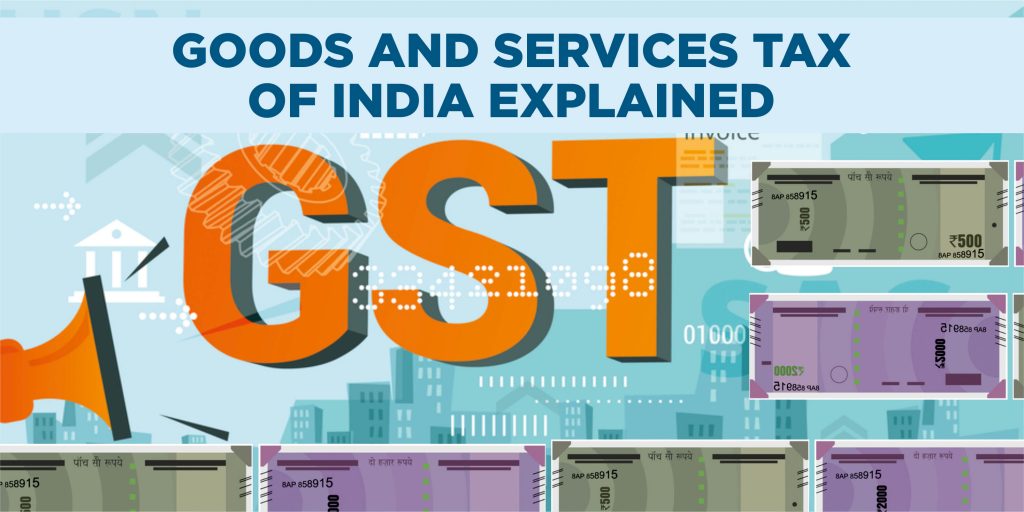What Is GST In India? Goods And Services Tax Explained
In the year 2017, India went through a major economic reform – the Goods and Services Tax, an indirect tax, was passed by the Parliament of India on 29th March 2017 and came into effect on 1st July 2017. In this article let’s talk about the What Is GST? Goods And Services Tax Explained With Benefits!
What Is GST?
GST benefits are numerous, and one of the primary reasons why GST is making taxes simpler and easier is because Goods and Services Tax Law in India is an easy, multi-stage, destination-based tax that is levied on every added value. This means that GST benefits businesses and consumers alike by streamlining the tax system and reducing the burden of compliance. Additionally, GST benefits the economy as a whole by increasing transparency and reducing tax evasion.
Furthermore, the GST benefits extend to the fact that it is an Indirect Tax that has replaced many Indirect Taxes in India. This simplifies the tax structure and reduces the number of taxes that businesses and consumers have to navigate, making it easier for them to comply with tax laws.
Overall, the GST benefits include greater efficiency, transparency, and simplicity in the tax system, making it easier for businesses to operate and for consumers to understand their tax liabilities.
Before GST – The Confusion
Before the implementation of GST, there was a troublesome tax pattern which was actively followed in India, right from the purchase of raw materials to the final sale to the consumer.
There were many Value Added Taxes (VAT) and Excise Duties applied through the following stages of the product:
- At the stage of buying the raw material
- During the manufacturing process of the product.
- Adding the same during the phase of selling the product to wholesalers as well as warehousing the product.
- During the transfer of the product from wholesalers to retailers.
- Finally when the same was sold to the consumers
Before GST, the statutory tax rate for most goods was about 26%. Pre-GST there were many taxes which were levied by both the state and central governments. Every state had a different set of rules and regulations and mainly collected taxes in the form of Value Added Tax. Whereas, interstate sale of goods was taxed by the Center. There were many more taxes which were applied to many of the goods and services such as Central Excise Duty, Duties of Excise,
Additional Duties of Excise, Additional Duties of Customs, Special Additional Duty of Customs, Cess, State VAT, Central Sale Tax, Purchase Tax, Luxury Tax, Entertainment Tax, Entry Tax, Taxes on Advertisements and lastly Taxes on lotteries, betting and gambling.
So, to replace the existing multiple cascading taxes levied by the central and state governments, GST was introduced as one unified Indirect Tax.
Aftermath Of GST
GST brings several benefits to the table. Firstly, it eliminates the cascading effect of taxes, which means that taxes are charged only on the value added at each stage of production or distribution. This reduces the overall tax burden on businesses and consumers. Additionally, GST has simplified the tax structure, making it easier for businesses to comply with tax laws. It has also made interstate transactions simpler, as there is now a single tax rate applicable across the country. This has led to a more uniform tax regime and has helped to reduce tax evasion.
Another significant benefit of GST is that it has reduced the overall cost of doing business. Businesses no longer need to maintain multiple tax accounts or comply with complex tax laws in different states. This has resulted in significant savings in time and resources for businesses. Furthermore, GST has also helped to streamline the supply chain, making it more efficient and reducing logistical costs. Overall, the implementation of GST has led to greater transparency and accountability in the tax system, which has helped to build trust between businesses and the government.
In conclusion, GST has several benefits for businesses, including the elimination of the cascading effect of taxes, simplification of tax laws, reduction in the cost of doing business, and improved efficiency in the supply chain. By embracing GST, businesses can enjoy a more transparent and accountable tax regime, which can help them grow and prosper in the long run.
The retailer packages the potato chips in smaller quantities and invests in the marketing of the potato chips thus increasing its value.
One of the key GST benefits is that it is levied on the value additions made at each stage of the supply chain, from manufacturer to final sale to the end customer. This makes GST a multi-stage tax, with each stage contributing to the overall tax revenue. The GST benefits also include the fact that it is a destination-based tax, meaning that the tax revenue is collected at the point of consumption. For example, if a good is manufactured in one state and sold to a consumer in another state, the entire tax revenue will go to the destination state, rather than the state where the good was manufactured.
Another one of the GST benefits is that it simplifies the tax system by replacing multiple indirect taxes with a single tax. This reduces the burden of compliance for businesses and makes it easier for consumers to understand their tax liabilities. Additionally, GST benefits the economy by increasing transparency and reducing tax evasion, as every transaction is recorded and tracked under the GST system.
Overall, the GST benefits are numerous, and they include a simpler and more streamlined tax system, a multi-stage tax that captures value additions at each stage, and a destination-based tax that ensures tax revenue is collected at the point of consumption. These GST benefits contribute to a more efficient and effective tax system that benefits businesses, consumers, and the economy as a whole.
This indirect tax system under GST improves the collection of taxes as well as boost the development of the Indian economy by removing the indirect tax barriers between states and integrating the country through a uniform tax rate.
- The history of GST –
- 2000 – Former PM Vajpayee set up a committee to draft GST Law.
- 2004 – A task force concluded GST must be implemented to improve current tax structure.
- 2006 – First announcement of GST was made by the Union Minister during the 2006-2007 budget, that it would be introduced on April 1, 2010
- 2009 – Empowered Committee released the first Discussion Paper.
- 2011 – 115th Amendment Bill was introduced and subsequently lapsed.
- 2014 – 122nd Amendment Bill was introduced in Lok Sabha.
- 2016 August – One Hundred and First Amendment Act was enacted.
- 2016 September – The first GST Council Meeting was conducted.
- 2017 March – CGST, SGST, IGST, UTGST, and Compensation Cess Act was recommended by GST Council.
- 2017 April – CGST, SGST, IGST, UTGST, and Compensation Cess Act were passed.
- 1 July 2017 – GST laws, Goods and Services Tax was launched all over India.
- 7 July 2017 – Jammu and Kashmir state legislature passed its GST.
Streamline all Back End Operations so that you can save Time & Money and focus on GROWING YOUR BUSINESS.

Streamline all Back End Operations so that you can save Time & Money and focus on GROWING YOUR BUSINESS.
Accounting & Tax: Let us crunch the numbers, so you can focus on growing your business.
Virtual CFO: Experience financial success with a Virtual CFO by your side.
Internal Audit: Gain peace of mind with our comprehensive internal audit services.
Company Secretary: Let our experienced Company Secretary guide you through corporate compliance effortlessly.
Components And Rates Of GST –
India has implemented the Canadian model of Dual GST, i.e., both the Central and State Government will collect GST. There are basically 3 types of GST:
- CGST: Collected by the Central Government on an intra-state sale, i.e., transaction within a state.
- SGST: Collected by the State Government on an intra-state sale, i.e., transaction within a state
- IGST: Collected by the Central Government for an inter-state sale, i.e., transaction between two states.
As far as the rates are concerned, GST is imposed at variable rates on variable items. The rate of GST is 18% for soaps and 28% on washing detergents. GST on movie tickets is based on slabs, with 18% GST for tickets that cost less than Rs. 100 and 28% GST on tickets costing more than Rs.100 and 5% on readymade clothes. The rate of under-construction property booking is 12%. Some industries and products were exempted by the government and remain untaxed under GST, such as dairy products, products of milling industries, fresh vegetables & fruits, meat products, and other groceries and necessities.
A brief overview of the various slabs for products & services
| Slabs | GST Rates | Products and Services |
| 1 | 0% GST Rate | Fresh Meat, Fish Chicken, Eggs, Milk, Butter Milk, Curd, Natural Honey, Fresh Fruits and Vegetables, Flour, Besan, Bread, Prasad, Salt, Bindi Sindoor, Stamps, Judicial Papers, Printed Books, Newspapers, Bangles, Handloom etc. |
| 2 | 5% GST Rate | Fish Fillet, Cream, Skimmed Milk Powder, Branded Paneer, Frozen Vegetable, Coffee, Tea Spices, Pizza Bread, Rusk, Sabudana, Kerosene, Coal, Medicines, Stent, Lifeboats. |
| 3 | 12% GST Rate | Frozen Meat Products, Butter, Cheese, Ghee, Dry Fruits in Packaged form, Animal Fat, Sausage, Fruit Juices, Bhutia, Namkeen, Ayurvedic Medicines, Tooth Powder, Agarbatti, Colouring Books, Picture Books, Umbrella, Sewing Machine, and Cellphones. |
| 4 | 18% GST Rate | Flavoured Refined Sugar, Pasta, COnrflakes, Pastries and Cakes, Preserved Vegetable, Jams, Sauces, Soups, Ice Cream, Instant Food Mixes, Mineral Water, Tissues, Envelops, Tampons, Notebooks, Steel Products, Printed Circuits, Camera, Speakers, and Monitors. |
| 5 | 28% GST Rate | Chewing gum, Molasses, chocolate not containing cocoa, waffles and wafers coated with chocolate, pan masala, aerated water, Paint, Deodorants, shaving creams, aftershave, hair shampoo, Dye, Sunscreen, Wallpaper, ceramic tiles, water heater, Dishwasher, weighing machine, washing machine, ATM, vending machines, vacuum cleaner, Shavers, hair clippers, Automobiles, Motorcycles, aircraft for personal use, and yachts |
GST Rates were revised that was effective from January 25, 2018. On the 25th GST Council Meet, it was proposed to reduce the GST rates on selected goods and services. Based on this, GST Rates were revised on January 18, 2018, and the revised GST rates for both Central and State came into effect on January 25, 2018. The rates were revised on 29 Goods and 53 Services. GST Rates were revised from 28% to 18%, 28% to 12%, 18% to 12%, 18% to 5% and few were charged NIL GST and for very few products there was raise in GST Rates
Goods like alcohols for human consumption, petrol, and petroleum viz. Petroleum crude, High-speed diesel, Motor Spirit (petrol), Natural Gas, and Aviation turbine fuel are kept outside the GST slab rates.
Advantages Of GST:
GST was mainly introduced to remove the cascading effect on the sale of goods and services. This directly impacted the cost of goods and services. Since the tax on tax is eliminated in this regime, the cost of goods decreases.
Apart from this, GST in itself is very technologically driven. All activities like registration, return filings, application for refunds and responses to notice needs are done online on the GST Portal. This speeds up the overall process
Here is a brief overview of the advantages pertaining to GST:
- Removing the cascading effects of a tax on tax
- Higher threshold registration.
- Composition scheme for small business.
- Simpler online procedure under GST.
- Fewer compliances.
- Defined treatment for e-commerce.
- Increased efficiency in logistics.
- Regulating the unorganized sector.
- GST created a common market pan India.
- Attraction of foreign investment.
- Helps improve production thereby encouraging businesses to enter the international market.
- Consumers face benefits while purchasing from small retailers.
Who Pays GST?
GST is paid by all manufacturers and sellers. It is also paid by service providers such as telecom providers, consultants, chartered accountants etc. However, being an indirect tax, GST is also ultimately borne by the end consumers.
How To Register For GST Online?
As it was mentioned earlier, that GST is technologically driven. With regards to this, there is a singular registration process available online on the GST Portal.
Here’s a step-by-step guide on how to register for GST Online.
Keep the following documents on hand:
- Photographs.
- Constitution of the Taxpayer.
- Proof of the place of business.
- Bank account details.
- Authorization form.
- Step 1 – To register for the very first time, start by visiting the GST Portal – www.gst.gov.in
- Step 2 – On the GST Homepage, click on Register Now under Taxpayers (Normal).
- Step 3 –
- Select for New Registration
- In the drop-down under “I am a” – select Taxpayer
- Choose State and District from the drop down
- Enter the Name of Business and PAN of the business
- Type in the Email Address and Mobile Number. The registered email id and mobile number will receive the OTPs.
- Click on Proceed
- Step 4 – Enter the OTP which you received on your email and mobile. Click on Continue. If you have not received the OTP click on Resend OTP.
- Step 5 – You will receive the Temporary Reference Number (TRN) now. This will also be sent to your email and mobile. Note down the TRN.
- Step 6 – Once again go to the GST portal (www.gst.gov.in). Click on Register Now.
- Step 7 – Select Temporary Reference Number (TRN). Enter the TRN and the captcha code and click on Proceed.
- Step 8 – You will receive an OTP on the registered mobile and email. Enter the OTP and click on Proceed.
- Step 9 – You will see that the status of the application is shown as drafts. Click on Edit Icon.
- Step 10 – Fill in all the details and submit appropriate documents.
- Photographs.
- Constitution of the Taxpayer.
- Proof of the place of business.
- Bank account details.
- Authorization form.
- Step 11 – Once all the details are filled in go to the Verification page. Tick on the declaration and submit the application using any of the following ways –
- Companies must submit an application using DSC.
- Using e-Sign – OTP will be sent to Aadhaar registered number.
- Using EVC – OTP will be sent to the registered mobile.
- Step 12 – A success message is displayed and Application Reference Number (ARN) is sent to registered email and mobile.
You can check the ARN status for your registration by entering the ARN in GST Portal.
And, for simple and trouble-free GST solutions opt for Brego Business Accounting Services.



